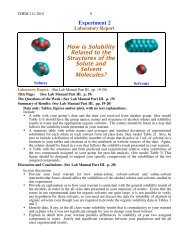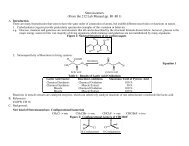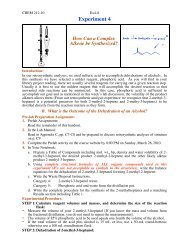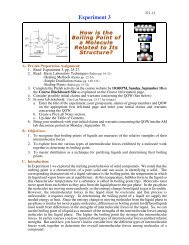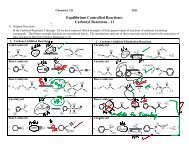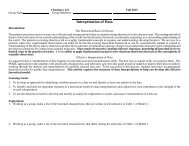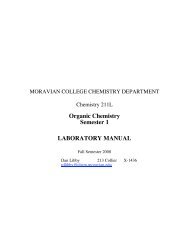Organic Chemistry Semester 1 LABORATORY MANUAL - Moravian ...
Organic Chemistry Semester 1 LABORATORY MANUAL - Moravian ...
Organic Chemistry Semester 1 LABORATORY MANUAL - Moravian ...
You also want an ePaper? Increase the reach of your titles
YUMPU automatically turns print PDFs into web optimized ePapers that Google loves.
Part V. Experiments 30 Fall 2010<br />
E. Introduction:<br />
In the experiments over the last few weeks, we have developed an understanding of the<br />
relationships between molecular structure and intermolecular forces. In Experiment 5 we<br />
apply this understanding to determine the purity of solid substances. Each student will be<br />
given a crude sample of an unknown solid organic compound. In Part A we will explore<br />
experimental methods for judging the purity of the compounds and in Part B we will purify<br />
the samples.<br />
1. Chromatography:<br />
In general, chromatography is defined as the separation of a mixture of two or more<br />
different compounds or ions by distribution between two phases, one of which is<br />
stationary and the other mobile. Various types of chromatography are possible,<br />
depending on the nature of the two phases involved. Table 1<br />
Type Stationary Phase Mobile Phase<br />
Solid-Liquid<br />
(column, thin layer or tlc, paper)<br />
Liquid-Liquid<br />
Gas-Liquid<br />
(GC or GLC)<br />
finely divided solid<br />
(Silica or Alumina)<br />
viscous liquid coated on<br />
a finely divided solid<br />
viscous liquid coated on<br />
a finely divided solid<br />
organic liquids<br />
with varying polarity<br />
organic liquids<br />
with varying polarity<br />
inert gas<br />
(He, Ar, N 2 )<br />
All chromatographic methods work on the same principle, the differential affinities of the<br />
substances to be separated between the two phases. This experiment deals with column<br />
and thin-layer chromatography, which are based on adsorptivity of compounds on a solid<br />
surface vs. their solubilities in a liquid solvent.<br />
In solid-liquid chromatography, the stationary phase is a finely divided solid that may be<br />
any substance that is not soluble in the associated liquid phase. Solids commonly used in<br />
chromatography are alumina (Al 2 O 3 ), and silica (SiO 2 ); both of these compounds are<br />
very polar. In this experiment the solid used will be finely divided silica, often called<br />
silica gel.<br />
If a solution containing an organic compound is added to finely divided silica (or<br />
alumina) some of the organic compound will adsorb onto the surface of the fine particles<br />
of silica. This adsorption occurs because of the intermolecular forces created between<br />
the silica and the organic molecules. As we have seen in our studies of boiling points and<br />
solubility, if the organic molecules are non-polar, the forces will be weak (London<br />
Dispersion forces). Since London forces arise from electrons in non-polar covalent<br />
bonds, non-polar molecules will not adsorb well on the surfaces of polar silica gel<br />
particles unless the organic molecule has a large surface area (usually high molecular<br />
weight compounds). If the molecule is polar, the attractive forces between the molecule<br />
and silica gel particles can be strong (hydrogen bonding or dipole-dipole interactions).<br />
The more polar the compound, the more strongly will it adsorbed onto the silica (or<br />
alumina) surface. These interactions are very similar to those we saw affecting solubility<br />
in Experiments 2 and 3.<br />
In chromatography, the principles of adsorptivity and solubility are important because<br />
they are competing for the components of the sample being separated. Solutes adsorbed<br />
onto a solid phase (silica or alumina) can be removed by a solvent if the solvent has a<br />
higher affinity for the solute than does the solid phase. Initially, the substance(s) to be<br />
separated, referred to as the eluates, are adsorbed onto the surface of the silica or<br />
alumina. If the solvent (eluent) polarity is increased, the solubilities of the eluates<br />
increase removing some of their molecules from the solid phase (desorbing them)<br />
causing them to move with the eluent. The process of adsorption and desorption is a<br />
dynamic equilibrium.<br />
Column chromatography is usually used as a method to separate mixtures and isolate the<br />
components. Thin-layer chromatography is most often used to analyze very small sample<br />
to judge purity of a sample and identify the components.



